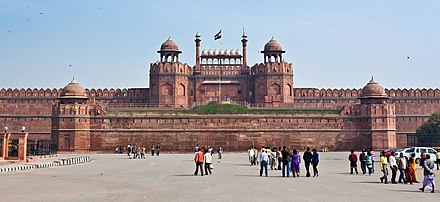The Evolution of Delhi's Architecture: From Mughals to Modern

Delhi, the heart of India, is a city that bridges two different worlds. The old and the new. From the labyrinthine streets of Old Delhi to the orderly avenues of New Delhi, the city embodies a past that is filled with alluring mysteries and magnificent monuments. Here, we will explore the evolution of Delhi’s architecture, from the Mughal era to the modern times.
1. The Red Fort
The majestic Red Fort is not just a monument; it’s a symbol of India’s sovereignty, hosting the country’s Independence Day celebrations each year. Built by the Mughal emperor Shah Jahan in the 17th century, this architectural marvel showcases the fusion of Persian, Islamic, and Indian architectural styles. Its red sandstone walls have witnessed centuries of history and stand as a testament to the grandeur of the Mughal Empire.

2. Qutub Minar
Standing tall at 73 meters, the Qutub Minar is an architectural marvel of ancient India. This UNESCO World Heritage Site was built in the 12th century by Qutub-ud-din Aibak, the founder of the Delhi Sultanate. The minaret is adorned with intricate carvings and Quranic inscriptions, offering a glimpse into the Islamic heritage of India. It is a prime example of Indo-Islamic architecture, blending elements of Persian, Turkish, and Indian styles.

3. Humayun’s Tomb
Humayun’s Tomb, built in the 16th century, is a UNESCO World Heritage Site and a precursor to the magnificent Taj Mahal. It was commissioned by Emperor Humayun’s wife, Empress Bega Begum, and showcases the early Mughal architectural style. The tomb’s red sandstone facade, intricate marble inlays, and beautiful gardens make it a must-visit monument in Delhi.

4. Jama Masjid
Jama Masjid, the largest mosque in India, is another architectural gem of Delhi. Built by Emperor Shah Jahan in the 17th century, it showcases the grandeur of Mughal architecture. The mosque’s red sandstone and white marble facade, intricate carvings, and spacious courtyard make it a significant religious and cultural landmark in Delhi.

5. Rashtrapati Bhavan
Rashtrapati Bhavan, the official residence of the President of India, is a masterpiece of colonial architecture. Designed by British architect Edwin Lutyens, it showcases a blend of Indian and European architectural styles. The grand building, with its sprawling gardens and intricate detailing, is a symbol of India’s democratic heritage.

6. India Gate
India Gate, a war memorial located in the heart of New Delhi, is an iconic symbol of the city. Designed by Edwin Lutyens, it was built to honor the Indian soldiers who lost their lives during World War I. The majestic arch, surrounded by lush green lawns, stands as a tribute to the bravery and sacrifice of the Indian armed forces.

7. Lotus Temple
The Lotus Temple, also known as the Bahá’í House of Worship, is a modern architectural marvel in Delhi. Designed in the shape of a lotus flower, it is a place of worship for people of all religions. The temple’s serene atmosphere, stunning architecture, and beautiful gardens make it a popular tourist attraction.

8. Akshardham Temple
Akshardham Temple, a relatively new addition to Delhi’s architectural landscape, is a masterpiece of modern Indian architecture. Built in 2005, it showcases the rich cultural and spiritual heritage of India. The temple’s intricate carvings, stunning architecture, and captivating light and sound show make it a must-visit destination for tourists.

9. National Museum
The National Museum of India, located in New Delhi, is a treasure trove of Indian history and culture. The museum’s architecture, with its blend of traditional and modern elements, reflects the diversity and richness of India’s heritage. From ancient sculptures and artifacts to contemporary art, the museum offers a comprehensive journey through India’s past and present.

10. National Rail Museum
The National Rail Museum, located in Chanakyapuri, is a unique museum that showcases the history and development of railways in India. The museum’s collection includes vintage locomotives, carriages, and other railway artifacts. It offers a fascinating glimpse into the evolution of transportation in India and is a must-visit for railway enthusiasts.

🕌✨🇮🇳
Delhi’s architecture is a testament to the city’s rich history and cultural heritage. From the grandeur of the Mughal era to the modern marvels of today, each monument tells a unique story. Exploring these architectural wonders is like taking a journey through time, experiencing the evolution of Delhi’s vibrant past. So, when you visit Delhi, make sure to immerse yourself in the beauty and grandeur of these must-see monuments.
For more information about Delhi’s monuments and travel tips, visit Delhi Tourism.
